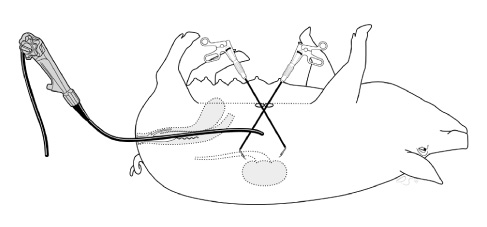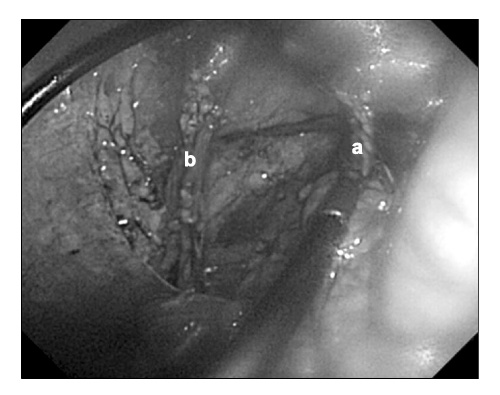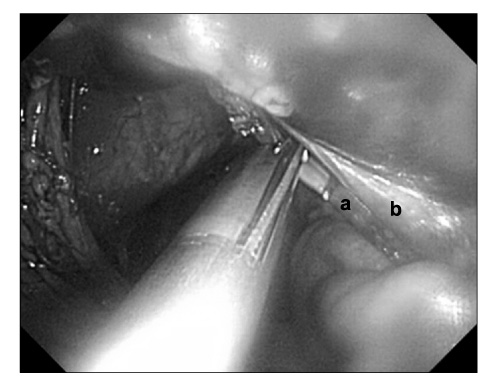Korean J Urol.
2009 May;50(5):505-507.
Hybrid Transvaginal Gastro-Endoscopic Nephrectomy in a Porcine Model
- Affiliations
-
- 1Department of Urology, Yonsei University College of Medicine, Seoul, Korea. hanwk@yuhs.ac
- 2Department of Urology, Hanyang University College of Medicine, Seoul, Korea.
Abstract
- This animal experimental study reports one case of hybrid transvaginal natural orifice transluminal endoscopic surgery (NOTES) for nephrectomy. We performed a nephrectomy through a transvaginal access and 2 additional 5 mm trocars in the abdomen by using the keyhole technique. The specimen was removed through the vaginal tract. The total procedure time was 102 minutes. There were no intraoperative complications.
Keyword
MeSH Terms
Figure
Reference
-
1. Bardaro SJ, Swanstrom L. Development of advanced endoscopes for Natural Orifice Transluminal Endoscopic Surgery (NOTES). Minim Invasive Ther Allied Technol. 2006. 15:378–383.2. Sclabas GM, Swain P, Swanstrom LL. Endoluminal methods for gastrotomy closure in natural orifice transenteric surgery (NOTES). Surg Innov. 2006. 13:23–30.3. Swain P. Nephrectomy and natural orifice translumenal endoscopy (NOTES): transvaginal, transgastric, transrectal, and transvesical approaches. J Endourol. 2008. 22:811–818.4. Swain P. A justification for NOTES--natural orifice translumenal endosurgery. Gastrointest Endosc. 2007. 65:514–516.5. McGee MF, Rosen MJ, Marks J, Onders RP, Chak A, Faulx A, et al. A primer on natural orifice transluminal endoscopic surgery: building a new paradigm. Surg Innov. 2006. 13:86–93.6. de la Fuente SG, Demaria EJ, Reynolds JD, Portenier DD, Pryor AD. New developments in surgery: Natural Orifice Transluminal Endoscopic Surgery (NOTES). Arch Surg. 2007. 142:295–297.7. Flora ED, Wilson TG, Martin IJ, O'Rourke NA, Maddern GJ. A review of natural orifice translumenal endoscopic surgery (NOTES) for intra-abdominal surgery: experimental models, techniques, and applicability to the clinical setting. Ann Surg. 2008. 247:583–602.8. Duepree HJ, Senagore AJ, Delaney CP, Fazio VW. Does means of access affect the incidence of small bowel obstruction and ventral hernia after bowel resection? Laparoscopy versus laparotomy. J Am Coll Surg. 2003. 197:177–181.9. Branco AW, Branco Filho AJ, Kondo W, Noda RW, Kawahara N, Camargo AA, et al. Hybrid transvaginal nephrectomy. Eur Urol. 2008. 53:1290–1294.10. McGee MF, Marks JM, Onders RP, Chak A, Rosen MJ, Williams CP, et al. Infectious implications in the porcine model of natural orifice transluminal endoscopic surgery (NOTES) with PEG-tube closure: a quantitative bacteriologic study. Gastrointest Endosc. 2008. 68:310–318.
- Full Text Links
- Actions
-
Cited
- CITED
-
- Close
- Share
- Similar articles
-
- Transvaginal Endoscopic Appendectomy
- Novel method of laparoendoscopic single-site and natural orifice specimen extraction for live donor nephrectomy: single-port laparoscopic donor nephrectomy and transvaginal graft extraction
- The Impact of Using a Porcine Model in Laparoscopic Partial Nephrectomy Training
- Recent development of innovative resection methods for gastric neoplasms using hybrid natural orifice transluminal endoscopic surgery approach
- Comparison of the Intraparenchymal Biocompatibility of Oxidized Regenerated Cellulose and Porcine Small Intestine Submucosa in Rat Kidney




